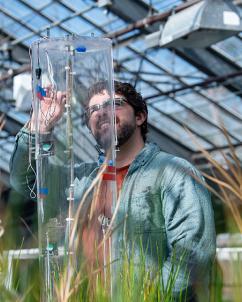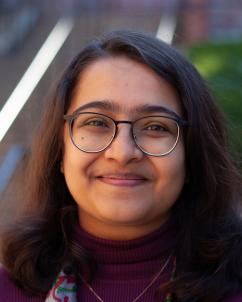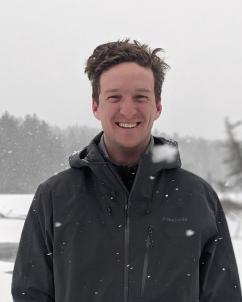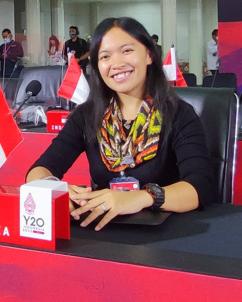
Knowledge & leadership for a sustainable future
News & Research

What Does the Future Hold for National Forests? Yale School of the Environment experts discuss the potential impacts of increased logging on national forest lands, including on wildfire risks and efforts to combat climate change.
Research Day: Be Inspired by Next-Generation Innovators
The Yale School of the Environment’s Annual Research Day gives students from across YSE and Yale an opportunity to keep up with – and draw inspiration from – their colleagues’ work. Listen to Botao Zhao, Eileen Zhang, Leo Goldsmith, and Destiny Treloar talk about the insights they gained on the complex relationship between global economic upheaval and local economic transformations; green chemistry incubators; mental health burden outcomes among displaced populations after a disaster; and food insecurity at times of crisis.
Make the Most of Your Environment
Learn more from alumni, students, and faculty about YSE's unique community of environmental researchers, practitioners, and educators.

YSE Celebrates 125 Years of Leadership, Innovation, and Impact The Yale School of the Environment has been educating the next generation of environmental leaders and helping to meet some of society’s greatest challenges since 1900. Today, the community is working on climate solutions while looking at the challenges and opportunities ahead.
Real-World Impacts

Maximizing Forest Carbon Removal
YSE scientists mapped out natural pathways in U.S. forests to remove 1 billion tonnes of carbon dioxide per year and store it on a gigaton scale, a figure necessary to help meet national net-zero emissions goals. Sara Kuebbing, research scientist and director of the Yale Applied Science Synthesis Program, led a team evaluating forest management practices in the Northeast, Western, and Southeastern U.S. They found that regenerative silviculture practices, fire management techniques, and planting new forests are critical to increasing forest resilience and carbon storage capacity. The findings were part of a U.S. Department of Energy report.

Strengthening Tribal Co-Management of Public Lands
Working with stakeholders from the federal government, tribal communities, and conservation groups, the Yale Center for Environmental Justice (YCEJ) in partnership with The Forest School completed a first-of-its-kind white paper that sets a foundation for Tribal co-management of public lands.
There are more than 600 million acres of public lands in the U.S. of which 100 million acres are Indigenous lands.
“Tribal co-management is truly a force multiplier. It places real decision making in the hands of our original stewards,” said Pat Gonzales Rogers, YSE lecturer and co-author of the paper.

Evaluating Impacts of Ephemeral Streams on Water Quality
A study by YSE researchers that documented the impacts of ephemeral streams on river output is helping to evaluate the effects of a Supreme Court decision that limited federal jurisdiction over their regulation under the Clean Water Act.
The study, co-authored by Peter Raymond, Oastler Professor of Biogeochemistry, found that ephemeral streams, which flow only briefly after precipitation events, influence a substantial amount of water output of the nation’s rivers and are likely a significant pathway through which pollution may influence downstream water quality.

Amplifying Diverse Voices on the Climate Crisis
The Yale Program on Climate Change Communication (YPCCC) co-led an initiative with The OpEd Project aimed at diversifying voices in the public discourse on climate change. The project trained 80 fellows who published more than 300 articles and thought-leadership pieces in media outlets such as The New York Times, The Washington Post, BBC Newshour, and USA Today on the climate crisis.
“Climate change affects everyone, but it especially impacts women, people of color, and other marginalized groups whose voices and perspectives are often unheard in public policy debates,” YPCCC Director Anthony Leiserowitz said.

Mainstreaming Nature in U.S. Policy
Eli Fenichel, Knobloch Family Professor of Natural Resources, played a critical role in ensuring that information about nature is included in U.S. policy and federal decision-making process. He helped draft a first-of-its-kind guidance that provides a blueprint for assessing the impacts of federal rules on natural assets.
“Mainstreaming nature is taking a systems thinking approach, with a bit of extra care to make sure information about nature enters the process — in ways it often has not in the past,” Fenichel said. “It is good governance.”

Measuring the Inflation Reduction Act’s Effectiveness
Matt Ashenfarb, a YSE doctoral candidate is studying the effects of the Inflation Reduction Act (IRA) on local economies, specifically its role in expanding clean energy investments. In one study, Ashenfarb and coauthors found that investment in clean energy projects roughly doubled in economically disadvantaged communities and parts of the country typically reliant on fossil fuel production. “The preliminary data suggest that IRA policies are working as intended,” Ashenfarb said. “Clean investments are growing everywhere, but particularly in those places that otherwise stood to lose most from the transition to a clean-energy economy.”
In the Media
‘An outlier’: why does the US rank low on demands for climate action?Jennifer Marlon
Activate climate’s ‘silent majority’ to supercharge action, experts sayAnthony Leiserowitz
Changing climate: what does America think of global warming?Jennifer Marlon
Not just the planet: the climate crisis is also affecting our mindsAnthony Leiserowitz
America's climate anxiety, mappedYale Program on Climate Change Communication
How is conservation preparing for a much hotter world? Experts shareOswald Schmitz
Meet Our Students and Alumni

Creating a Water Security Program for the Navy
Water is fundamental to public health, food supplies, and energy production, and therefore vital to national security. Kelsey Semrod ’16 MESc, a water resilience program manager with the Office of the Assistant Secretary worked to establish the first comprehensive water security program for the Navy. Now, as a senior scientist at the Pacific Northwest National Laboratory, she supports the Department of Energy (DOE) and Department of Defense (DOD) on water resilience issues, including leading water resources management training for DOD and DOE utility managers and supporting a new water and energy resilience program for DOE's Water Power Technology Office.

Sara Cody ’26 MEM/JD
Goal:Expedite decarbonization by helping to move clean energy projects to implementation on the legal side
Sara Cody entered Yale with the goal of pursuing a career in environmental litigation. However, her studies in the joint degree program at the Yale School of the Environment and Pace University’s Elisabeth Haub School of Law led her in a different direction. Her courses gave her a deeper understanding of environmental economics — and the inseparability of market forces and climate change mitigation, she said.
“My focus has shifted to more affirmative decarbonization efforts,” Cody said.
After she graduates, Cody would like to work with clean energy companies on legal agreements that allow them to build out key environmental infrastructure projects.

Phoebe Merrick ’25 MEM/MPH
Goal: Quantifying and communicating the impacts of climate change on public health
Phoebe Merrick believes that she can have the most impact on climate mitigation efforts by communicating more directly to the public about how climate change affects human health. Using the data visualization skills she learned at Yale, Merrick plans to pursue work in quantitative analysis and climate communication, helping to display data in ways that are accessible to the general public.
“We talk about the economic reasons to mitigate climate change, but we don’t talk as often about the health benefits,” she said. “I think that there's a place to move health communications to the forefront.”

Colby Richardson ’25 MEM
Goal: Reducing corporate supply chain emissions
Vermont is the third-most forested state of the U.S. mainland, with approximately 4.5 million acres of forestland covering nearly 80% of its territory. After witnessing the destructive effects of mining activity on the state’s forests, Colby Richardson’ 25 MEM, who grew up in the rural town of Thetford, was inspired to study environmental policy in college.
Richardson spent several years working in environmental consulting and at an online renewable energy marketplace. He came to YSE with the goal of deepening his quantitative skills to build a business case for sustainability, and last summer he interned at The Coca-Cola Company, where he focused on the company’s sustainability strategy. After graduating, Richardson would like to continue working to reduce supply chain emissions.

Olivia Rhodes ’25 MEM
Goal: Mitigate climate change through carbon dioxide removal
In her first semester at the Yale School of the Environment, Olivia Rhodes ’25 MEM took a class in carbon dioxide removal (CDR). The class changed the direction of her studies.
Rhodes arrived at YSE with a desire to focus on energy after a stint at a bioenergy firm, but when she learned of CDR’s potential for helping to abate greenhouse gas emissions, she saw an opportunity in a growing field.
“At the rate we're going without reducing our overall emissions, there's going to be a bigger need for it with every passing year,” Rhodes said. “CDR is an area that's very much still being created.”

Accelerating the Clean Energy Transition in Indiana
Over the past seven years, George Gemelas ’18, '21 MEM has worked to educate people, mainly young Americans, about climate change, clean energy, and carbon dividends—the policy of putting a price on carbon emissions and returning the money directly to the people.
As a fellow at the Mitch Daniels Leadership Foundation, a development program for young professionals, Gemelas launched Build Clean Indiana to accelerate the clean energy transition in Indiana and inform fellow Hoosiers of business opportunities made available by continuing to grow the state’s clean economy. “Our strong business environment, our pragmatism, and our excellence in agriculture and industry will be needed to meet our country’s environmental challenges.”

A Market-based Approach to Climate Action in Washington
Washington state is aiming to eliminate or offset its greenhouse gas emissions by 2050. Mike Johnson ‘16 MEM heads the auction process of the state’s cap-and-invest program, which has generated massive revenue for investments in climate resiliency, clean transportation, and other community programs.
“Washington taking action on climate change through a market-based approach not only creates financial incentives to reduce emissions but also drives innovation in energy production and carbon removal — whether through natural processes or engineered solutions. Our goal is an economy-wide transition away from carbon fuels, toward more efficient, equitable, and sustainable solutions.”

Tracking Big Cats in the Sierra Madres Mountains
Siria Gámez tracks big cats — all the way up 80-foot trees. A doctoral student in YSE's Applied Wildlife Ecology lab, Gámez had special training to set up camera traps in the tree canopy of the El Triunfo Biosphere to examine how jaguars, pumas, and other carnivores use vertical spaces in the Sierra Madre de Chiapas mountains in Mexico.
“This particular region of Mexico is quite understudied,” says Gámez. “We’re exploring how these animals survive in this three-dimensional forest structure.”

Mahica Iyer, United Arab Emirates
Goal: Engage in sustainable business and development projects that empower local communities
Ever since she was a child, Mahica Iyer ’25 MEM has straddled two worlds: She grew up amid the glittering towers of Dubai, UAE. The community in her hometown of Mumbai, meanwhile, experienced frequent power outages, a scarcity of clean water, and poor waste management. Iyer later attended college in Illinois and then went on to work as a consultant in supply chain sustainability.

Experiments in Reducing Methane Emissions
Researching natural ways to reduce greenhouse gas emissions, Ben Girgenti ’22 MESc tested whether adding minerals to wetland ecosystems can reduce biological methane emissions. After adding iron to the soil of mini wetlands, Girgenti found that methane was reduced by the mineral enhancement.
“If you’re building or using wetlands for natural carbon capture, you could shut off or decrease methane emissions, reducing the amount of time it takes for wetlands to begin having new sequestration of carbon,” Girgenti says.
Benedicta Asiedu, Ghana
Goal: Advancing Ghana’s transition to a net-zero economy
Benedicta Asiedu ’25 MEM has witnessed profound economic transformation in her home country of Ghana. It is one of the world’s largest exporters of gold, and it exports agricultural goods, most significantly cacao, to global markets. Since 2007, when oil in commercial quantities was first discovered, Ghana has also become a producer and exporter of crude oil. These three commodities alone have helped the country move from the edge of economic collapse three decades ago to, as the World Bank declared in 2019, the world’s fastest growing economy. (This growth has since slowed.)

Srishti Singh, India
Goal: Merge finance and water management for a more just and secure water future
According to the World Bank, the Global South could lose up to 6% of its GDP by 2050 due to water scarcity, with women and the poor most vulnerable.
Srishti Singh ’25 MEM is well aware of these, and many other, water-related challenges, as she most recently worked at India’s Central Pollution Control Board, where she was the sole social scientist on a team of physical scientists. “I realized I needed interdisciplinary training to become an effective leader in the water and climate space,” she says. “This led me to Yale.”

Tracking Bear Movements
After Rae Wynn-Grant ’10 MESc studied bears in the Nevada mountains, the National Geographic Society sent her to conduct similar work with the American Prairie Reserve in the grasslands of Montana — a region where bears are not common.
The nonprofit is seeking create a national wildlife refuge. Wynn-Grant began working with carnivores while at YSE, tracking lions in Tanzania. She has leaned on her expertise to predict which habitats will attract bears, using state and federal data and camera traps to monitor bear movements and habitats.

Stewarding Forests in the Face of Climate Change
Forests help mitigate climate change because of their ability to remove and store carbon dioxide from the atmosphere, but they become carbon emitters during wildfires. PhD student Reid Lewis '20 MF is researching how satellite data and machine learning models can help fire-prone forests become more resilient.
“When we make these forests more fire resilient, we can not only store more carbon, we can also help protect human communities, foster wildlife habitat, safeguard watersheds, and can use the process of restoration to partner with and empower Indigenous nations,” says Lewis.

Empowering Young Leaders
In July, Indonesia hosted the Y20 Summit, an annual gathering of youth leaders from G20 nations. This year's summit emphasized a sustainable and livable planet, and its recommendations will be presented at the upcoming G20 Summit in November. Caroline Tasirin ’19 MFS — a lecturer in the forestry program at Indonesia’s Sam Ratulangi University and co-founder of SULUT Semangat, a program that empowers Indonesian youths to connect with nature — represented the host nation and served as co-chair of the selection committee for Indonesia. “I'm proud to have contributed my insight and honored to collaborate with diverse youth leaders,” she says.
Fast Facts
2024 Incoming Cohort
35%
International Students
35% of the 2024-2025 master's cohort are from outside the United States.
95%
Receive Financial Aid
95% of incoming master's students who completed the YSE aid application will receive financial aid.
2023 Incoming Masters
21%
5+ Years Work Experience
21% of incoming master's students have more than five years of work experience.
20-46
Age Range
The current class of first-year master’s students at YSE range in age from 20 to 46, with an average of 26. Our incoming class enters with an average of 3 to 4 years of professional experience.
2024 Incoming Cohort
23/31
Countries/States
In our Fall 2024 class, students come from 23 countries and 31 states and U.S territories.
Degrees & Programs
The Yale School of the Environment offers a variety of degree programs, many of which can be customized to meet each student’s professional goals, and prepare them for careers in environmental science, management, and policy.
RESEARCH DEGREES
PROFESSIONAL DEGREES
Centers, Programs, and Initiatives

60+ Tools
Twenty-first century cities need practical solutions to ensure a sustainable, resilient future for their citizens. The Hixon Center for Urban Sustainability offers interactive toolkits practitioners can use in adapting solutions to meet the challenges facing existing cities as well as those not yet built.


